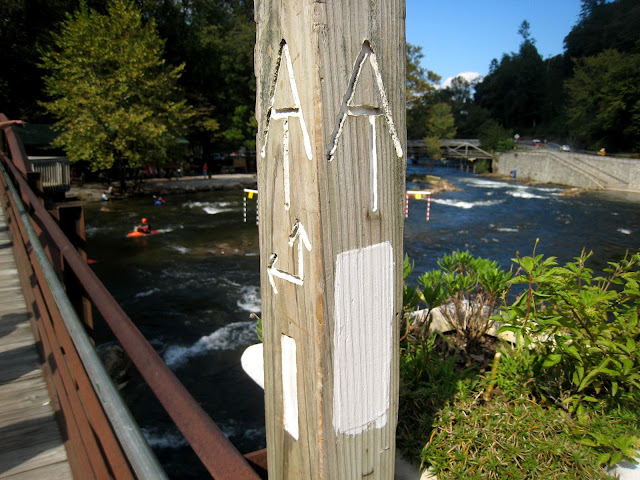Show Me America
HIGHWAYS AND BYWAYS, Day 23:
Columbia, MO to West Plains, MO
Our
first order of business this morning was getting two of Ken's
prescriptions refilled. Since it was last filled at a Kroger store, we
thought we'd try the pharmacy at the local Gerbes supermarket, a chain
in the same corporate family as Kroger. Sure enough, the pharmacist was
able to pull up his records with no problem. Then she broke the news
that she couldn't fill the prescriptions.
"There's a little
problem," she said. "Your insurance is telling me you are female, and
you obviously are not. I'm not able to override the information and can't
fill them otherwise. Here's a number you can call to get your insurance
company to make the correction so I can fill your prescriptions."
Who knew? Without so much as a
consent for treatment, let alone a bit of anesthesia, Ken had apparently
undergone gender reassignment at the hands of a United Healthcare
employee, who probably wasn't even a licensed physician anyway. Half an
hour later, he had painlessly lost that extra
x chromosome and was back to his manly self with refilled prescriptions. Whew!
With our errand finally complete, we pointed the car south on US-63. Our final destination for today was West Plains, Missouri, near the Arkansas border, but the road went straight through Jefferson City, the state capital. Since we were driving that way, we decided to have a look at the state capitol building
(pictured above) and take a few photos.
Driving up to the edifice, we were amazed to score a parking place at the curb directly in front of the entrance, just a few feet from a "3 HOUR VISITOR PARKING" sign. Not believing our good luck, we scoured the area for a parking meter or a pay-and-display kiosk but found none. It was not only convenient, it was free!
We each took our cameras and walked around the capitol grounds snapping pictures, not really paying attention to each other. As I was trying to figure out how to photograph the ornate detail on the portico ceiling, I received a text message from Ken: "Incredible inside!"
What? How did he get through security so quickly? I walked up the
stairs and right into the rotunda, expecting to submit my bag and
electronics for scanning, ready to remove my belt with its heavy buckle
before walking through the metal detector. Instead of armed security
guards and an x-ray machine, I was greeted only by a tasteful sign
notifying me that weapons are prohibited in the building. Oh, OK, the
security station must be at the top of the stairs.
 |
| Inside Capitol entrance |
But no. All I found there was more stunningly beautiful architecture and decor and Ken walking around marveling about the building. After we wandered through the halls for a while, taking photographs and locating restrooms, we stumbled upon a charming woman named Helen walking through the lobby with a small pot of coffee.
 |
| Capitol dome interior |
Legislative assistant to a Missouri state representative from the Kansas City area, Helen has worked at the capitol for 13 years. When we told her how impressed we were with the openness of the capitol building, she explained that just after the 9/11 tragedies, Missouri had installed strict security for about a year. Then everyone tired of it and decided they didn't need it.
Wow! It was like a breath of fresh air rushing into a landfill. We were experiencing America as it used to be in the pre-2001 days of trust and innocence. It was wonderful. What a contrast to our visit to the U.S. Capitol in April, when we were put through three separate security screenings and then asked to put all our belongings into a locker before proceeding inside.
 |
| Some of the Thomas Hart Benton murals depicting Missouri history |
Helen was a delightful ambassador for the state and the capitol building. She insisted that we see the marvelous Thomas Hart Benton murals in the House reception room and visit the House chamber. She even invited us to step up to the Speaker's podium for a photo op if we wanted. In addition to her genuine hospitality, Helen was extremely knowledgeable about the capitol and its history, as was the assistant House clerk who asked if we were in town for the Mizzou/UGA game in Columbia on Saturday, Missouri's first foray into the SEC. (We were not.)
 |
| Our volunteer tour guide, Helen |
By the time we left Helen, we had been given an impromptu 30-minute personal tour of the Missouri capitol and experienced a great reminder of America as it used to be. Unfortunately for Helen, her coffee by then was stone cold, but she assured us she was happy to reheat it. We spent a few minutes checking out the excellent Missouri history museum in the building before departing. Even there, the atmosphere of trust was pervasive. Rather than having exhibits all behind glass, there were items that visitors could pick up and examine. Welcome to the old America.
Continuing our drive south from Jefferson City, we began to notice the beginnings of the Ozarks as we left the flatlands behind. Limestone strata lined the roadside where hills had been bisected for the highway. After stopping for a picnic lunch at a scenic overlook, we consulted the weather radar and decided to continue south on the more direct route of US-63, rather than taking the scenic route down MO-19. A large storm system was headed our way, which we figured would effectively block our views of the scenic spots.
 |
| Stormy weather approaching |
By 3:00, the storm caught up with us just as we arrived in the little town of Houston. A strong wind buffeted the car as lightning flashed and the rain pelted down. Radar indicated we were close to the edge of the storm and it was moving pretty fast, so we decided to stop and wait it out in the local McDonald's parking lot. Within half an hour, the storm had pretty much passed over. Skies no longer looked dark and foreboding, so we continued on down to West Plains, where we searched for a couple of letterboxes and a place to plant our Missouri box before calling it a day as another storm system threatened.
THURSAY, 6 SEPTEMBER 2012
MISSOURI STATS
- Population: 6,010,688 (18th)
- Land area: 69,704 sq. mi. (21st largest)
- Highest point: Taum Sauk Mountain - 1,772 ft.
- Nickname: The Show Me State
- Statehood: 1821 (#24)
- Capital: Jefferson City
- Largest city: Kansas City
- Nickname: Show Me State
- Famous natives: Mark Twain, Harry S. Truman, Chuck Berry, Yogi Berra, George Washington Carver, Walter Cronkite, J.C. Penney, Dick Van Dyke, Rush Limbaugh, Eugene Field
- Claims to fame:
- bordered by eight other states
- starting point for Oregon Trail and Pony Express
- top lead producing state
- only state with 2 Federal Reserve Banks (Kansas City & St. Louis)
- hosted first Olympic games in the United States, 1904
 |
| Missouri's House of Representatives chamber |
 |
| Statue of Jefferson City's eponym |
 |
| Detail on the capitol portico |






























































